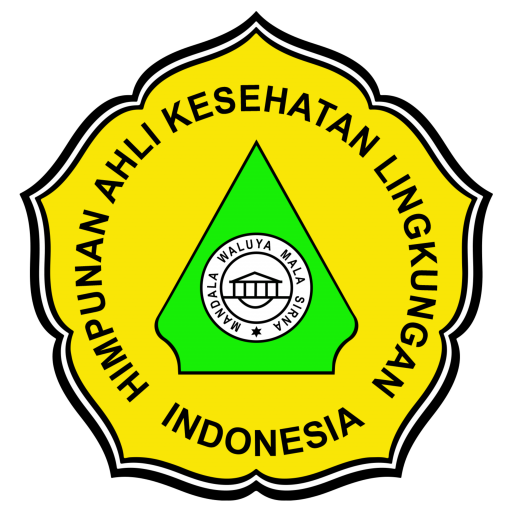Analisis Bibliometrik: Tren Penelitian Pengolahan Limbah Cair 2019-2024
Abstract
Pengolahan limbah cair merupakan masalah lingkungan utama yang telah mendapatkan perhatian besar dalam penelitian ilmiah karena dampaknya terhadap kesehatan masyarakat dan lingkungan. Penelitian ini bertujuan untuk mengidentifikasi tren penelitian dalam bidang pengolahan limbah cair selama lima tahun terakhir (2019-2024) untuk memberikan rekomendasi perkembangan riset tentang pengolahan limbah cair dimasa mendatang. Data diperoleh dari basis data artikel ilmiah Google Scholar, Sqopus, dan PubMed. Penelusuran menggunakan aplikasi Publish or Perish dengan kata kunci wastewater treatment dan dianalisis menggunakan VOSviewer. Hasil analisis menunjukkan peningkatan signifikan dalam jumlah publikasi pada tahun 2020, diikuti oleh penurunan hingga tahun 2024. Topik utama dan terbaru yang muncul meliputi photocatalytic degradation, antibiotik, microplastic, ARGs, microalga, dan energy recovery. Temuan ini memberikan dasar ilmiah yang kuat untuk merumuskan kebijakan, inovasi teknologi, serta pendekatan preventif sekaligus memberikan saran kepada peneliti dalam melakukan kajian penelitian yang mengarah pada topik-topik tersebut dimasa mendatang.
Keywords
Full Text:
PDFReferences
Karunasena G, Gajanayake A, Wijeratne WMPU, Milne N, Udawatta N, Perera S, et al. Liquid waste management in the construction sector: a systematic literature review. Int J Constr Manag. 2024;24(1):86–96.
Balaji K, Sakthivel R, Tamilarasan N, Pranay P, Rishiyadhav G, Subrajith SP, et al. Overview of biodiesel production from liquid wastes. In: Waste Valorization for Bioenergy and Bioproducts. Elsevier; 2024. p. 251–81.
Edokpayi JN, Odiyo JO, Durowoju OS. Impact of wastewater on surface water quality in developing countries: a case study of South Africa. Water Qual. 2017;10(66561):10–5772.
Widyarani, Wulan DR, Hamidah U, Komarulzaman A, Rosmalina RT, Sintawardani N. Domestic wastewater in Indonesia: Generation, characteristics and treatment. Environ Sci Pollut Res. 2022;29(22):32397–414.
Zapata-Mendoza PCO, Berrios-Tauccaya OJ, Tirado-Kulieva VA, Gonzales-Malca JA, Ricse-Reyes DR, Berrios-Zevallos AA, et al. Environmentally friendly technologies for wastewater treatment in food processing plants: a bibliometric analysis. Sustainability. 2022;14(22):14698.
Tarrass F, Benjelloun M. The effects of water shortages on health and human development. Perspect Public Health. 2012;132(5):240–4.
Rahman ROA, Ibrahium HA, Hung YT. Liquid radioactive wastes treatment: a review. Water. 2011;3(2):551–65.
Van Eck N, Waltman L. Software survey: VOSviewer, a computer program for bibliometric mapping. Scientometrics. 2010;84(2):523–38.
Tamtam S, Laguidi A, Elkalay A. Data integration systems and bibliometrics. In: ITM Web of Conferences. EDP Sciences; 2023. p. 1008.
de Sousa MNA, de Oliveira Almeida EP, Bezerra ALD. Bibliometrics: what is it? What is it used for? And how to do it? Cuad Educ y Desarro. 2024;16(2):e3042–e3042.
Feng R, Zheng H jun. Evidence for regional heterogeneous atmospheric particulate matter distribution in China: implications for air pollution control. Environ Chem Lett. 2019;17:1839–47.
Abd Elmohsen SA, Daigham GE, Mohmed SA, Sidkey NM. Photocatalytic degradation of biological contaminant (E. coli) in drinking water under direct natural sunlight irradiation using incorporation of green synthesized TiO2, Fe2O3 nanoparticles. Biomass Convers Biorefinery 2024 155 [Internet]. 2024 Apr 27 [cited 2025 Apr 5];15(5):6713–34. Available from: https://link.springer.com/article/10.1007/s13399-024-05602-5
Yada S, Nakajima Y, Itahashi S, Asada K, Yoshikawa S, Eguchi S. Procedure for rapid determination of δ15N and δ18O values of nitrate: development and application to an irrigated rice paddy watershed. Water Sci Technol. 2016;73(9):2108–18.
Ahmed W, Angel N, Edson J, Bibby K, Bivins A, O’Brien JW, et al. First confirmed detection of SARS-CoV-2 in untreated wastewater in Australia: a proof of concept for the wastewater surveillance of COVID-19 in the community. Sci Total Environ. 2020;728:138764.
Barboza LGA, Gimenez BCG. Microplastics in the marine environment: current trends and future perspectives. Mar Pollut Bull. 2015;97(1–2):5–12.
Li Y, Tao L, Wang Q, Wang F, Li G, Song M. Potential Health Impact of Microplastics: A Review of Environmental Distribution, Human Exposure, and Toxic Effects. Environ Heal [Internet]. 2023 Oct 20 [cited 2025 Apr 5];1(4):249–57. Available from: https://pubs.acs.org/doi/full/10.1021/envhealth.3c00052
Olguín EJ. Dual purpose microalgae–bacteria-based systems that treat wastewater and produce biodiesel and chemical products within a Biorefinery. Biotechnol Adv. 2012;30(5):1031–46.
Donthu N, Kumar S, Mukherjee D, Pandey N, Lim WM. How to conduct a bibliometric analysis: An overview and guidelines. J Bus Res. 2021;133:285–96.
Lodder W, de Roda Husman AM. SARS-CoV-2 in wastewater: potential health risk, but also data source. Lancet Gastroenterol Hepatol. 2020;5(6):533–4.
CDC. Understanding Antibiotic Resistance in Water | One Health | CDC [Internet]. CDC One Health. 2021 [cited 2025 Apr 5]. Available from: https://www.cdc.gov/one-health/php/stories/understanding-antibiotic-resistance-in-water.html
Rizzo L, Manaia C, Merlin C, Schwartz T, Dagot C, Ploy MC, et al. Urban wastewater treatment plants as hotspots for antibiotic resistant bacteria and genes spread into the environment: a review. Sci Total Environ. 2013;447:345–60.
Bell JNB, Power SA, Jarraud N, Agrawal M, Davies C. The effects of air pollution on urban ecosystems and agriculture. Int J Sustain Dev World Ecol. 2011;18(3):226–35.
Hasan HA, Muhamad MH, Ji B, Nazairi NA, Jiat KW, Sim SISWA, et al. Revolutionizing wastewater treatment with microalgae: Unveiling resource recovery, mechanisms, challenges, and future possibilities. Ecol Eng. 2023 Dec 1;197:107117.
Saleem F, Harris J, Zhang K, Harvey A. Non-thermal plasma as a promising route for the removal of tar from the product gas of biomass gasification–A critical review. Chem Eng J. 2020;382:122761.
DOI: https://doi.org/10.31983/keslingmas.v44i1.12443
Article Metrics
Refbacks
- There are currently no refbacks.

Buletin Keslingmas (p-ISSN : 0215-742X, e-ISSN : 2655-8033 ), diterbitkan oleh Jurusan Kesehatan Lingkungan Politeknik Kesehatan Kemenkes Semarang Jl Raya Baturaden Km. 12 Purwokerto, Jawa Tengah, Indonesia. Telp/Fax. 0281-681709
Email : buletinkeslingmas@poltekkes-smg.ac.id
Buletin Keslingmas is licensed under a Creative Commons Attribution 4.0 International License

.png)
.png)
.png)










